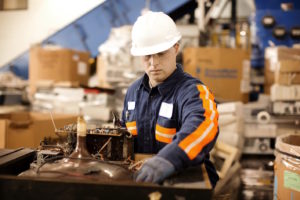Manufacturers of Electrical and Electronic Equipment (EEE) are increasingly moving away from the ‘linear economy’ in response to the demands of authorities and consumers. The old progression of ‘make, use, dispose’ is no longer acceptable. Manufacturers instead need to focus on developing commercially viable products that comply with market regulations and yet also conform to the demands of a ‘circular economy’.

The primary driver behind the concerns of environmentally aware consumers and NGOs is the ‘linear economy’ model’s inefficient use of resources. It uses high levels of raw materials and, because the product is disposed of when it reaches its end-of-life, it is wasteful. Consumers and authorities are starting to request products where the materials, components, and even the products themselves can be reused or repurposed. In a ‘circular economy’, resources are utilized for as long as possible.
The key principles of the ‘circular economy’ are sustainability, renewability and reusability. Manufacturers should be designing products with a focus on reuse, recovery and/or recycling. Durability, and the ability to restore, need to be considered in a model that intends to:
- Minimise the use of raw materials
- Maximise the useful life of materials and other resources through resource recovery
- Minimise the waste generated at the end-of-life of a product and its packaging
However, this model is not without its own difficulties. The costs associated with developing products in the ‘circular economy’ may be more unknown than those in the ‘linear economy’. For example, to create a product that conforms to the ‘circular economy’ model, it may have to be more robust and this sometimes means more of a raw material is required. The right raw material might also be environmentally unfriendly in comparison to a less robust material. These costs need to be offset against the greater value gained from developing a product that can be renewed, reused and recycled. It may be that by improving a product in these terms, the negatives created by making the product more robust are cancelled.
To design products for the ‘circular economy’ manufacturers need to introduce its philosophy from the very start of the design process. A new product needs to be designed to consider raw materials in relation to compliance and performance ability. Design engineers should also consider the perspective of ease of disassembling for reuse or material recovery. Leaving this until the end of the product development process may incur far greater costs for the company. Manufacturers also need to ensure their supply chains are robust in their ability to procure and supply materials and products that meet these design criteria.
Manufacturers should understand the materials they plan to use in their products, and the regulations put in place in relation to these materials that aim to protect the environment. The supply chain therefore becomes a vital part of the process. Manufacturers need to control their supply chains to ensure source materials comply with published regulations and do not originate from violent regions or areas where human employment practices fail to meet internationally accepted standards.
Best practices in terms of developing and producing EEE in the ‘circular economy’ involves a different attitude to product and raw material testing. Factors such as compliance testing and evaluation can no longer be left to the end of the development process, they need to be considered from the start. In this way, manufacturers can create products that conform to the demands of authorities and consumers, but which are still commercially viable.
SGS Electrical and Electronic Products
SGS understands the applicable regulations and can assist manufacturers of electrical and electronic products with evaluation and testing. In addition, with a global network of specialist laboratories able to provide assessment capabilities to the supply chain, SGS is ideally positioned to help manufacturers meet the design and construction criteria for the circular economy model.
 Instrumentation Monthly Test | Measurement | Control
Instrumentation Monthly Test | Measurement | Control




